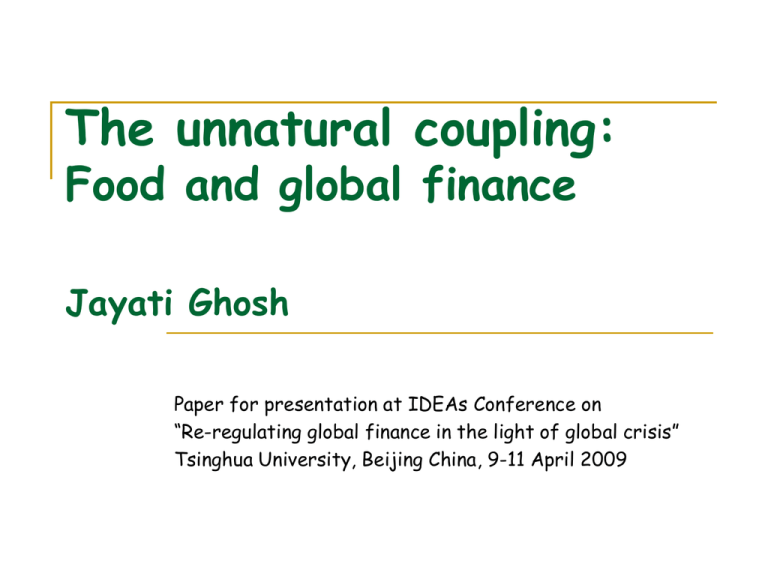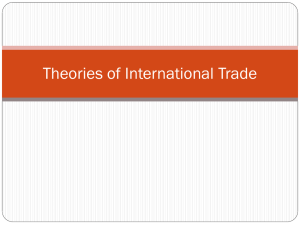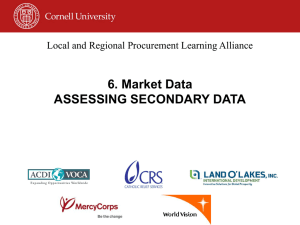The unnatural coupling: Food and global finance Jayati Ghosh
advertisement

The unnatural coupling: Food and global finance Jayati Ghosh Paper for presentation at IDEAs Conference on “Re-regulating global finance in the light of global crisis” Tsinghua University, Beijing China, 9-11 April 2009 The global food crisis Still continues even though it has lost public and media attention. Intimately connected with financial speculation which affected global trade prices. Massive – and unprecedented – changes in global trade prices of basic food grains and important cash crops especially over past two years. Current complacency because international prices have fallen is not warranted. Food insecurity in many developing countries is now even greater than before. Index numbers of world trade prices 340.0 290.0 240.0 Rice Wheat 190.0 Maize 140.0 90.0 Ja M M J Se n- ar- ay- ul- p06 06 06 06 06 No Ja v- n06 07 M M J Se ar- ay- ul- p07 07 07 07 No Ja v- n07 08 M M J Se ar- ay- ul- p08 08 08 08 No Ja M v- n- ar08 09 09 World trade prices 280.0 260.0 240.0 220.0 200.0 Cotton 180.0 Soyabean 160.0 Groundnut 140.0 120.0 100.0 80.0 Ja M M J Se No Ja M M J Se No Ja M M J Se No Ja M n- ar- ay- ul- p- v- n- ar- ay- ul- p- v- n- ar- ay- ul- p- v- n- ar06 06 06 06 06 06 07 07 07 07 07 07 08 08 08 08 08 08 09 09 Prices do not reflect real demand and supply Production has increased much faster than utilisation, leading to increase in stock holding (from admittedly low levels). Amount traded has actually fallen. Claim that increased demand from China and India has led to rising prices is completely unjustified, because both aggregate and per capita consumption has fallen in both countries. Basic facts of the world cereal situation (million tonnes) 2006-07 2007-08 2008-09 PRODUCTION 1 Wheat Coarse grains Rice (milled) SUPPLY 2 Wheat Coarse grains Rice UTILISATION Wheat Coarse grains Rice Per capita cereal food use (kg per year) TRADE 3 Wheat Coarse grains Rice 2 010.4 596.6 985.1 428.7 2 481.1 776.3 1 171.0 533.8 2 064.3 622.0 1 015.3 427.1 151.8 2 129.2 610.8 1 078.4 440.0 2 553.4 767.9 1 240.9 544.7 2 125.2 617.5 1 070.9 436.8 152.3 2 244.8 682.2 1 111.5 451.0 2 675.5 832.4 1 282.5 560.6 2 198.3 647.6 1 106.1 444.5 152.4 256.8 113.3 111.2 32.3 271.6 111.2 129.6 30.9 265.0 120.0 114.0 31.0 Per cent change: 2008-09 over 2007-08 5.4 11.7 3.1 2.5 4.8 8.4 3.4 2.9 3.4 4.9 3.3 1.8 0.1 -2.4 7.9 -12.0 0.3 Basic facts of the world cereal situation cont.(million tonnes) 2006-07 2007-08 2008-09 END OF SEASON STOCKS 4 Wheat - main exporters5 Coarse grains - main exporters5 Rice - main exporters5 424.3 157.0 36.6 162.5 62.3 104.7 23.1 430.7 150.2 27.7 171.0 73.7 109.6 26.0 474.3 182.9 42.7 175.2 64.8 116.2 29.2 Per cent change: 2008-09 over 2007-08 10.1 21.8 54.1 2.5 -12.1 6.0 12.2 Cereal production 1 excl. China and India Utilization Food use excl. China and India Per capita cereal food use (kg per year) excl. China and India Feed excl. China and India End of season stocks 4 excl. China and India 887.2 306.4 935.5 650.4 276.5 155.5 916.6 303.5 960.2 663.5 283.7 156.3 934.9 313.7 978.3 673.1 290.8 156.3 2.0 3.3 1.9 1.5 2.5 0.0 157.3 166.8 48.9 238.2 58.0 158.1 172.0 49.2 255.9 52.4 158.9 176.4 50.1 278.1 53.0 0.5 2.6 1.9 8.7 1.2 Some supply factors are and will be significant • short-run factor – diversion of both acreage and food crop output for biofuel production • medium term factors – – – – rising costs of inputs inadequate credit to cultivators falling productivity because of soil depletion inadequate public investment in agricultural research and extension – impact of climate changes on harvests Speculation and commodity futures markets Function of speculators is to predict future market patterns and thereby reduce the intensity of change - that is, reduce volatility and stabilise prices! Similarly, commodity futures markets are supposed to reduce risk for cultivators and purchasers: allow better risk management through hedging by different layers of producers, consumers and intermediaries; enable open-market price discovery of commodities through buying and selling on the exchanges; and therefore lead to lower transaction costs. Financial deregulation and commodity speculation - 1 In 2000, the Commodity Futures Modernization Act deregulated commodity trading in the United States, by exempting over-the-counter (OTC) commodity trading (outside of regulated exchanges) from CFTC oversight. Unregulated commodity exchanges allowed all investors, including hedge funds, pension funds and investment banks, to trade commodity futures contracts without any position limits, disclosure requirements, or regulatory oversight. The value of such unregulated trading was around $9 trillion at the end of 2007, more than twice the value of the commodity contracts on the regulated exchanges. Financial deregulation and commodity speculation - 2 “Swap-dealer loophole” in the 2000 legislation allowed traders to use swap agreements to take long-term positions in commodity indexes. Emergence of commodity index funds that were essentially “index traders” focussed on returns from changes in the index of a commodity, by periodically rolling over commodity futures contracts prior to their maturity date and reinvesting the proceeds in new contracts. Such commodity funds dealt only in forward positions with no physical ownership of the commodities involved. Financial deregulation and commodity speculation - 3 As US housing finance market imploded, finance searched for other avenues of investment to find new sources of profit, like commodity speculation . By around June 2008, when the losses in the US housing and other markets because intense, it became necessary for many funds to book their profits and move resources back to cover losses or provide liquidity for other activities. Commodity markets became like other financial markets, prone to information asymmetries and associated tendencies to be led by a small number of large players. Implications of financial speculation on food prices Inherently “wrong” signalling devices became very effective in determining and manipulating market behaviour. The result: excessive price volatility of commodities in 2008 – not only the food grains and cash crops, but also minerals, metals and oil. This had very adverse effects on both cultivators and consumers of food: Confusing, misleading and often completely wrong price signals to farmers that caused over sowing in some phases and under cultivation in others. High pass through of rising global prices on consumer prices in developing countries, but low pass through of falling prices on consumers. So both cultivators and food consumers lost out through extreme price instability. The only gainers were the financial intermediaries who were able to profit from rapidly changing prices. Continuing food crisis in developing world At the end of December 2008, FAO estimated that 33 countries were experiencing severe or moderate food crises, with conditions in at least 17 countries worse compared to October 2008. Many developing countries in which widespread and persistent hunger was already a problem, have experienced significant increases in the prices of staple foods in the past two years, and there has been hardly any decline even after global trade prices started falling. Changes in prices of food staples in some food-deficit developing countries Country and food item Zimbabwe Per cent increase in price Jan 2007-Dec 2008 994 wholesale white maize Ethiopia 141 wholesale white maize Malawi 107 wholesale white maize Kenya 81 wholesale white maize Zambia 32 wholesale white maize South Africa -38 wholesale white maize Honduras retail white maize Guatemala retail white maize Ethiopia wholesale wheat Eritrea wholesale wheat Sudan wholesale wheat 36 25 119 114 4 Country and food item Afghanistan retail wheat flour Pakistan retail wheat flour Thailand wholesale rice Colombia wholesale rice Bolivia wholesale rice Senegal imported rice Burkina Faso imported rice Niger imported rice Sri Lanka retail rice Haiti retail rice Nicaragua retail rice Per cent increase in price Jan 2007-Dec 2008 114 82 73 76 30 85 65 44 30 94 54 Index numbers of rice prices in some Asian countries 350.0 300.0 Global trade price of rice 250.0 India Retail rice price China Second quality rice price 200.0 Bangladesh Coarse rice retail price Philippines retail rice price 150.0 100.0 Jan-09 Nov-08 Sep-08 Jul-08 May-08 Mar-08 Jan-08 Nov-07 Sep-07 Jul-07 May-07 Mar-07 Jan-07 Nov-06 Sep-06 Jul-06 May-06 Mar-06 Jan-06 50.0 Index numbers of rice prices in some developing countries 350.0 300.0 Global trade price of rice Colombia retail rice price 250.0 200.0 Sri Lanka Retail rice price 150.0 100.0 Ja n0 Ap 6 r-0 6 Ju l-0 Oc 6 t-0 Ja 6 n0 Ap 7 r-0 7 Ju l-0 Oc 7 t-0 Ja 7 n0 Ap 8 r-0 8 Ju l-0 Oc 8 t-0 Ja 8 n09 50.0 Ghana retail imported rice price Differential performance Some countries (e.g. China) have managed food situation much better than other. Domestic food production critical factor in this. Countries with high import propensity for food have been very badly affected, especially if they export cash crops. Lesson: No country, however small and open, can afford to neglect domestic food production and must ensure at least some domestic supplies, if it does not want to get caught in a vortex of price volatility that can dramatically affect national food security. Other national policy issues Effective state intervention for food price stability and food security requires fiscal resources – but developing countries already have large fiscal deficits as outcome of financial crisis. They are crowded out of international capital markets by US and other developed economies, as they guarantee their own private debt and expand fiscal deficits. Private capital moving out also causes currency devaluation, so food imports become more expensive in local currency. So developing countries caught in pincer movement between volatile global prices and falling exports on the one hand, and reduced fiscal space and depreciating currencies on the other hand. Real economy measures Strong government interventions to protect developing country agriculture, to provide more public support for sustainable and more productive and viable cultivation patterns and to create and administer better domestic food distribution systems. International arrangements and co-operative interventions, such as strategic grain reserves, commodity boards and other measures to stabilise world trade prices Control of finance to stabilise food prices Very strict limits (even bans) on the entry of financial players into commodity futures markets. Elimination of the “swap-dealer loophole” that allows financial players to enter as supposedly commercial players. Banning of futures markets for grain trade in countries where public institutions play an important role in grain trade. Capital controls of different sorts on short-term capital flows, particularly to prevent their destabilising impact on domestic food prices. Thank you for your attention!

